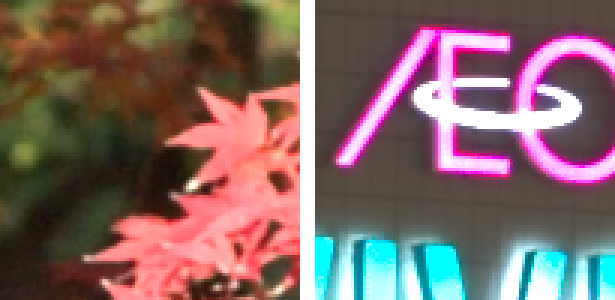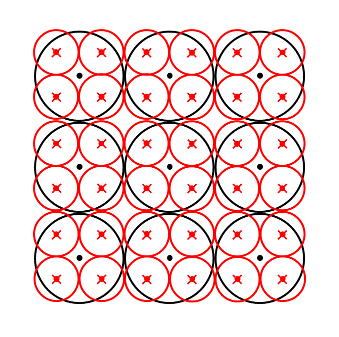Technical Information
This is an example of applying our technology to a 360° camera. See also this blog for more details.
 <Image from a conventional 360° camera>
<Image from a conventional 360° camera>
 <AI super-resolution developed image by AIRD + SRSZ + Visual Sharpness>
<AI super-resolution developed image by AIRD + SRSZ + Visual Sharpness>
Optical Learning®
"Optical Learning® (Achromatic restoration technology)" removes all aberrations and blurring of the lens by AI. See also this blog for more details.(Japanese Registered trademark No. 5896153, Janapese Patent No. 6164564, US Patent US10,291,844, Korean patent 2,011,938)
Optical Learning® Principles
An optical simulation is performed from the lens design data, based on the results, a dictionary corresponding to the image position is generated by AI (machine learning). Use the dictionary to restore aberration-free.
 <Optical simulation>
<Optical simulation>
 < Learning >
< Learning >
 < Restore >
< Restore >
Conventional aberration correction technology
As an aberration correction technology that appeals to high image quality, it is incorporated as a function in offline editing machines. In addition, for surveillance cameras, etc. are on sale as those that can realize real time. However, there is no technology to correct all aberrations with high accuracy from lens design data.
As a problem of conventional aberration correction technology,
・Since the filter is used to shift the pixels, the central part with high resolution is also blurred.
・There are many methods using approximate expressions, and it cannot be corrected. Distortion remains. The line is jagged. There are problems such as.
・The stretched part of the surrounding area is blurred.
・Lens aberrations other than distortion cannot be corrected.
・High image quality cannot be corrected in real time.
Etc.
Effect of Optical Learning®
- Realization of reality of no aberration...It restores all aberrations such as wide-angle lenses, fisheye lenses, and endoscopes, as well as distortion and blur caused by dimming and MTF. In other words, any camera can be made aberration-free.
- Achieves image quality (SN standard about 40 dB) comparable to professional Codec.
- Improves inexpensive lenses to a higher level of performance. (Example: HD lens → 4K lens)
 <before> GoPro Hero4
<before> GoPro Hero4
 <after> GoPro Hero4 + Optical Learning®
<after> GoPro Hero4 + Optical Learning®
 <before> GoPro Hero4
<before> GoPro Hero4
 <after> GoPro Hero4 + Optical Learning®
<after> GoPro Hero4 + Optical Learning®
 <before> GoPro Hero4
<before> GoPro Hero4
 <after> GoPro Hero4 + Optical Learning®
<after> GoPro Hero4 + Optical Learning®
 <before> GoPro Hero4
<before> GoPro Hero4
 <after> GoPro Hero4 + Optical Learning®
<after> GoPro Hero4 + Optical Learning®
 <before> GoPro Hero4
<before> GoPro Hero4
 <after> GoPro Hero4 + Optical Learning®
<after> GoPro Hero4 + Optical Learning®
 <before> GoPro Hero4
<before> GoPro Hero4
 <after> GoPro Hero4 + Optical Learning®
<after> GoPro Hero4 + Optical Learning®
* This is an example of our Optical Learning® GoPro Hero4. The lens was analyzed by Fit.
Application of Optical Learning®
- It can be applied to all types of cameras and photography equipment such as single-lens cameras, action cameras, drones, surveillance cameras, endoscopes, automobiles, and smartphones.
- It is effective for optical systems such as endoscopes where there are many restrictions on lens design.
- By reducing the number of lenses and improving the yield, it will lead to cost reduction and compactness.
- It is also effective for stitching, CG, VR, image recognition, measurement, robots, etc.
 <Endoscope>
<Endoscope>
 <Monitoring camera>
<Monitoring camera>
 <Drone>
<Drone>
 <Action camera>
<Action camera>
 <Automobile>
<Automobile>
 <Smartphone>
<Smartphone>
 <Single-lens reflex camera>
<Single-lens reflex camera>
In fact, most cameras are distorted.
There may come a time when only distortion-free cameras can be sold, just as ordinary CRT TVs can no longer be sold when flat CRT TVs are released.
AIRD™(Artificial Intelligence Retina Development)
"AIRD (Artificial Intelligence Retina Development)" is a RAW development (demosaic) technology that reproduces the function of the human retina using AI super resolution. Eliminates zipper noise and artifacts, and eliminates sensor noise, optical LPF and diffraction blur. And the biggest feature is that it is not easily affected by chromatic aberration of magnification and axial chromatic aberration and is not easily deteriorated.(Japanese Patent No. 6435560, Former Phase Shift Development)

AIRD concept
Instead of using R and B pixels, only G pixels and AI super resolution are used to shift twice the G pixels by half a pixel to generate them. By not using R and B pixels to generate G pixels, zipper noise and artifacts are not generated in principle.
In addition, since the image is generated only from the highly sensitive G image, the actual sensitivity is high. It goes well with RCCB and RYYB sequences.
![]() <Pixel position generated by conventional demosaic (DLMMSE)>
<Pixel position generated by conventional demosaic (DLMMSE)>
![]() <Pixel position generated by AIRD>
<Pixel position generated by AIRD>
 <Conventional(DLMMSE) block diagram>
<Conventional(DLMMSE) block diagram>
 <AIRD block diagram>
<AIRD block diagram>
Conventional demosaic technology
Artifacts such as zipper noise and false colors are almost always present. One of the causes is that it may be caused by the influence of lens aberration.
As a problem of conventional demosaic technology,
・Artifacts such as zipper noise occur
・False color
・Reduced resolution
・Degraded resolution of red and blue images
・Zipper noise and false color due to chromatic aberration
Etc.
AIRD effect
- It completely suppresses artifacts such as zipper noise, and eliminates false colors caused by zipper noise.
 <DLMMSE(conventional) development>
<DLMMSE(conventional) development>
 <AIRD development>
<AIRD development>
- It also suppresses false colors.
 <DLMMSE(conventional) development>
<DLMMSE(conventional) development>
 <AIRD development>
<AIRD development>
- It is not easily affected by chromatic aberration of magnification and axial chromatic aberration, and suppresses zipper noise and false color.
 <DLMMSE(conventional) development>
<DLMMSE(conventional) development>
 <AIRD development>
<AIRD development>
- By AI(machine learning) the optical LPF and diffraction phenomenon, blurring due to the optical LPF and diffraction is removed.
 <DLMMSE(conventional) development(Aperture F22)>
<DLMMSE(conventional) development(Aperture F22)>
 <AIRD Optical LPF/diffraction learning development(Aperture F22)>
<AIRD Optical LPF/diffraction learning development(Aperture F22)>
- Since it is generated only from the highly sensitive green image, the actual sensitivity is high, and sensor noise can also be suppressed by AI(machine learning) the sensor noise.
 <DLMMSE(conventional) development(Shooting in the dark)>
<DLMMSE(conventional) development(Shooting in the dark)>
 <AIRD noise learning development(Shooting in the dark)>
<AIRD noise learning development(Shooting in the dark)>
- When used in combination with Optical Learning® or super-resolution, it is possible to suppress the emphasis on image quality deterioration due to demosaic.
Defective pixel correction by AIRD
- Ultra-high quality defective pixel correction using AI is also possible with demosaic processing.AIRD no kekkan gaso hosei no shōsai ni tsuite wa buroguni mo nosete orimasu. Details of AIRD's defective pixel correction are also posted on our blog.
 <DLMMSE dark spot>
<DLMMSE dark spot>
 <DLMMSE Defective pixel correction>
<DLMMSE Defective pixel correction>
 <AIRD Defective pixel correction>
<AIRD Defective pixel correction>
The detailed of AIRD are also posted on the blog. Please also refer to here for the detailed evaluation of AIRD.
・Difference in image quality due to demosaic (outdoor version ①)
・Difference in image quality due to demosaic (outdoor version ②)
・Difference in image quality due to demosaic (night view)
・Difference in image quality due to demosaic (indoor version ①)
・Difference in image quality due to demosaic (indoor version ②)
・Difference in image quality due to demosaic (indoor version ③)
KRM™(Keep Resolution Mapping)
"KRM(AI super-resolution geometric transformation)" is a unique technology that uses AI super-resolution to perform geometric transformation without reducing resolution.
SRSZ™(Super Resolution Stepless Zoom)
"SRSZ(AI super-resolution stepless zoom)" is a stepless electronic zoom that uses AI super-resolution. See also this blog for more details.
Principle of KRM / SRSZ
By combining phase shift using AI super-resolution and aperture correction using AI super-resolution, geometric transformation (keystone correction) and stepless zoom can be restored without resolution deterioration.

KRM and SRSZ are actually exactly the same algorithms.
 <principle>
<principle>
 <Half pixel shift to generate 4 pixels>
<Half pixel shift to generate 4 pixels>
 <4x dense blurred image>
<4x dense blurred image>
 <1/4 aperture correction>
<1/4 aperture correction>
Effect of KRM / SRSZ
Geometric transformation (keystone correction) and stepless zoom can be freely restored without deterioration of resolution. (Conventional learning-type super-resolution and deep learning could only restore to the specified teacher resolution.)
 <x3 zoom with Mitchell Filter>
<x3 zoom with Mitchell Filter>
 <x3 zoom with SRSZ>
<x3 zoom with SRSZ>
 <a7sii JPEG + x3 zoom with Mitchell Filter>
<a7sii JPEG + x3 zoom with Mitchell Filter>
 <a7sii RAW + AIRD + x3 zoom with SRSZ>
<a7sii RAW + AIRD + x3 zoom with SRSZ>
Visual Sharpness™
"Visual Sharpness" is an AI super-resolution sharpness that changes only the tilt without adding edges based on the visual model. See also this blog for more details.
Traditional Sharpness
This is an adjustment function to supplement the viewing environment such as screen size and distance, and the viewer's eyesight.

On YouTube etc., there are many people who edit with smartphones, and I see many images with borders that are over-sharpened.
Visual Sharpness Principle
AI super-resolution Visual Sharpness that changes only the tilt without adding edges based on the visual model.

Effect of Visual Sharpness
 <Original>
<Original>
 <Traditional sharpness>
<Traditional sharpness>
 <Traditional sharpness>
<Traditional sharpness>
 <Visual Sharpness>
<Visual Sharpness>
 <Original>
<Original>
 <Traditional sharpness>
<Traditional sharpness>
 <Traditional sharpness>
<Traditional sharpness>
 <Visual Sharpness>
<Visual Sharpness>
Visual AI®
"Visual AI®" projects far and near like the human eye. Depth of field control technology using AI(machine learning) realizes pan focus by AI. (Japanese Registered trademark No. 6365294, Japanese Patent No. 6694626)
Visual AI® Principles
By combining optical learning® with a distance measuring means such as a stereo camera, you can create an image that can be projected as far or near as the human eye.
 <principle>
<principle>
 <Real world>
<Real world>
 <Single-lens reflex camera>
<Single-lens reflex camera>
 <deep focus>
<deep focus>
 <focus>
<focus>
 <Out of focus>
<Out of focus>
 <Machine learning>
<Machine learning>
 <Distance measurement>
<Distance measurement>
 <Restore>
<Restore>
 <Visual AI>
<Visual AI>
Can a person see far or near by measuring the distance with both eyes and changing the resolution with the brain? I made a hypothesis. "Visual AI®" has realized this mechanism by AI(machine learning).
Effects of Visual AI®
・In order to increase the depth of field, the image sensor cannot be enlarged due to optical issues.
・The aperture ratio of the image sensor is back-illuminated and has reached its limit, making it difficult to increase the sensitivity.
・Visual AI® is the only way to design an easy-to-use camera with deep depth of field and high sensitivity.
・Visual AI® achieves ideal deep focus with a lot of information.